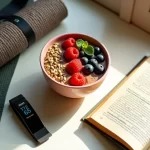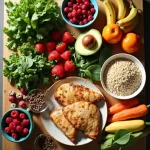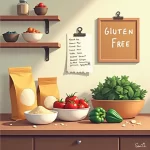We all want to eat healthier, and grabbing a ‘healthy’ snack seems like a great way to stay on track. But what if your go-to snacks aren’t as wholesome as they appear? Many so-called healthy snacks are packed with hidden sugars, unhealthy fats, and artificial additives that can sabotage your health goals. In this article, we’ll uncover the hidden dangers in your favorite snacks and provide tips to help you make smarter, truly healthy choices.
What Makes a Snack ‘Healthy’?
The Illusion of Health
Food packaging often uses buzzwords like “natural,” “organic,” or “low-fat” to create the illusion of health. However, these labels can be misleading.
Key Indicators of Truly Healthy Snacks
- Minimal Ingredients: Look for snacks with simple, recognizable ingredients.
- Low Added Sugar: Avoid snacks with high fructose corn syrup or other sweeteners.
- Healthy Fats: Opt for snacks with unsaturated fats like nuts or seeds.
Understanding these indicators can help you avoid falling for marketing gimmicks.
The Sugar Trap in ‘Healthy’ Snacks
Hidden Sugars in Plain Sight
Many ‘healthy’ snacks, like granola bars or yogurt, contain hidden sugars that can spike your blood sugar levels and lead to weight gain.
Common Culprits
- Flavored Yogurt: A single serving can contain up to 20 grams of sugar.
- Granola Bars: Often loaded with syrups and sweeteners.
- Dried Fruit: While natural, it’s concentrated in sugar and calories.
Always check the nutrition label for added sugars and opt for unsweetened versions.
The Fat Factor: Not All Fats Are Equal
Misleading Low-Fat Labels
Low-fat snacks often replace fats with sugars or artificial additives to maintain flavor, making them less healthy than their full-fat counterparts.
Healthy vs. Unhealthy Fats
- Healthy Fats: Found in nuts, seeds, and avocados.
- Unhealthy Fats: Trans fats and hydrogenated oils in processed snacks.
Choose snacks with natural, healthy fats to support heart health and satiety.
Artificial Additives and Preservatives
The Chemical Cocktail
Many ‘healthy’ snacks contain artificial flavors, colors, and preservatives that can harm your health over time.
Common Additives to Avoid
- Artificial Sweeteners: Linked to digestive issues and cravings.
- Food Dyes: Associated with hyperactivity in children.
- Preservatives: Can disrupt gut health and immunity.
Stick to snacks with minimal processing and no artificial ingredients.
Overeating ‘Healthy’ Snacks
The Portion Size Problem
Even healthy snacks can lead to weight gain if you overeat. Nuts, for example, are nutrient-dense but high in calories.
Tips for Mindful Snacking
- Pre-Portion Snacks: Divide large packages into single servings.
- Eat Slowly: Savor each bite to avoid overeating.
- Listen to Your Body: Stop eating when you’re satisfied, not stuffed.
Mindful snacking helps you enjoy your treats without overindulging.
Gluten-Free and Vegan Pitfalls
Not Always Healthier
Gluten-free and vegan snacks can still be high in sugar, salt, and unhealthy fats. Don’t assume they’re automatically better for you.
What to Look For
- Whole Ingredients: Choose snacks made with whole grains, nuts, or seeds.
- Low Sodium: Avoid snacks with excessive salt.
- Balanced Nutrition: Ensure snacks provide protein, fiber, and healthy fats.
Always read labels to ensure these snacks align with your health goals.
The Deceptive Power of Marketing
How Brands Mislead Consumers
Clever marketing can make unhealthy snacks appear healthy. Bright packaging, buzzwords, and health claims often distract from the actual ingredients.
How to Spot Red Flags
- Long Ingredient Lists: Indicates heavy processing.
- Unfamiliar Ingredients: Likely artificial additives.
- Health Claims: Phrases like “all-natural” or “guilt-free” can be misleading.
Focus on the nutrition facts, not the packaging.
Healthier Alternatives to Popular Snacks
Swap Out the Bad for the Good
You don’t have to give up snacking—just choose better options. Here are some healthy swaps:
- Instead of Chips: Try air-popped popcorn or veggie sticks with hummus.
- Instead of Candy Bars: Opt for dark chocolate or homemade energy balls.
- Instead of Sugary Yogurt: Choose plain Greek yogurt with fresh fruit.
These alternatives are just as satisfying but far more nutritious.
How to Read Labels Like a Pro
Decoding Nutrition Labels
Understanding nutrition labels is key to making informed choices. Here’s what to look for:
- Serving Size: Ensure you’re comparing equal portions.
- Added Sugars: Aim for less than 5 grams per serving.
- Ingredients List: The shorter, the better.
Arming yourself with this knowledge helps you avoid hidden dangers.
FAQs
Are protein bars healthy?
Not always. Many protein bars are high in sugar and artificial ingredients. Look for bars with minimal added sugars and whole-food ingredients.
Is trail mix a good snack?
It can be, but watch out for added sugars and salty nuts. Choose mixes with unsweetened dried fruit and raw nuts.
What’s the healthiest snack option?
Whole, unprocessed foods like fruits, vegetables, nuts, and seeds are the healthiest choices.
Can I trust ‘organic’ labels?
Organic snacks can still be high in sugar or unhealthy fats. Always check the nutrition label.
How can I satisfy my sweet tooth healthily?
Opt for fresh fruit, dark chocolate, or homemade snacks sweetened with natural ingredients like dates or honey.
Conclusion
Your favorite ‘healthy’ snacks might not be as good for you as you think. Hidden sugars, unhealthy fats, and artificial additives can turn a seemingly wholesome snack into a health hazard. By learning to read labels, choosing whole foods, and being mindful of portion sizes, you can enjoy snacks that truly support your well-being.
Take control of your snacking habits today. Swap out the imposters for real, nutritious options and fuel your body the right way. Your health is worth it!
Useful Links:
- American Heart Association: Understanding Food Labels
- Harvard School of Public Health: The Nutrition Source
By making smarter snack choices, you’re not just improving your diet—you’re investing in a healthier, happier you. Let’s snack smarter together!















